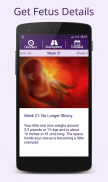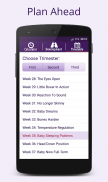








First Time Pregnancy

Description of First Time Pregnancy
<b>The App</b>
You are pregnant for the first time, what happens next? Get the world's most relevant timeline of your baby's development available right now.
Especially during your first pregnancy many questions and lack of information can lead to confusion or even anxiety about your own health. Our application offers an excellent insight into exploring the various aspects of pregnancy by providing a timeline, weekly information, due date calculation and milestones to keep you safe. We illustrate the journey from embryo to newborn baby with beautiful images, photos and ultrasounds of the baby in your womb, whilst giving you weekly updates from conception up to the birth of your child. The app was developed by a medical doctor with nothing but your health in mind.
Our application is offered as an educational tool to aid all interested to explore the fascinating and exciting world of pregnancy.Get it now and use it as your personal tracker.
<b>Pregnancy (by Wikipedia)</b>
In human reproduction, pregnancy (or gestation) is the development of one or more offspring, known as an embryo or fetus, in the uterus of a woman.
Childbirth usually occurs about 38 weeks after conception. In women who have a menstrual cycle length of four weeks, this is approximately 40 weeks from the start of the last normal menstrual period (LNMP). Health authorities recommend that women not artificially begin delivery with labor induction or caesarean section before 39 weeks as this amount of time is considered "full term" for the child to develop. Conception can be achieved through sexual intercourse or assisted reproductive technology.
An embryo is the developing offspring during the first 8 weeks following conception, and subsequently the term fetus is used until birth. In many societies' medical or legal definitions, human pregnancy is somewhat arbitrarily divided into three trimester periods of three months each, as a means to simplify reference to the different stages of prenatal development. The first trimester carries the highest risk of miscarriage (natural death of embryo or fetus). During the second trimester, the development of the fetus can be more easily monitored and diagnosed. The third trimester is marked by further growth of the fetus and the development of fetal fat stores. The point of fetal viability, or the point in time at which fetal life outside of the uterus is possible, usually coincides with the late second or early third trimesters; babies born at this early point in development are at high risk for having medical conditions and dying.
</br>
</br>

























